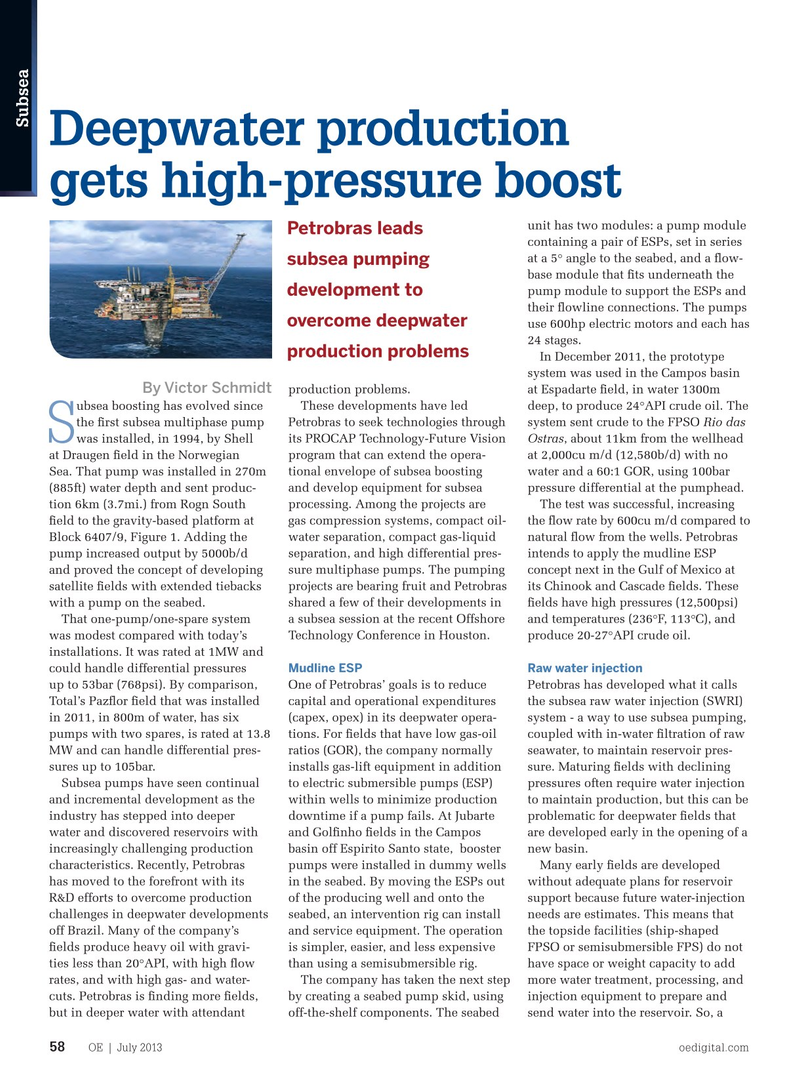
Page 56: of Offshore Engineer Magazine (Jul/Aug 2013)
Read this page in Pdf, Flash or Html5 edition of Jul/Aug 2013 Offshore Engineer Magazine
Subsea
Deepwater production gets high-pressure boost unit has two modules: a pump module
Petrobras leads containing a pair of ESPs, set in series at a 5° angle to the seabed, and a fow- subsea pumping base module that fts underneath the pump module to support the ESPs and development to their fowline connections. The pumps overcome deepwater use 600hp electric motors and each has 24 stages. production problems
In December 2011, the prototype system was used in the Campos basin
By Victor Schmidt production problems. at Espadarte feld, in water 1300m ubsea boosting has evolved since These developments have led deep, to produce 24°API crude oil. The the frst subsea multiphase pump Petrobras to seek technologies through system sent crude to the FPSO Rio das was installed, in 1994, by Shell its PROCAP Technology-Future Vision Ostras, about 11km from the wellhead
S at Draugen feld in the Norwegian program that can extend the opera- at 2,000cu m/d (12,580b/d) with no
Sea. That pump was installed in 270m tional envelope of subsea boosting water and a 60:1 GOR, using 100bar (885ft) water depth and sent produc- and develop equipment for subsea pressure differential at the pumphead. tion 6km (3.7mi.) from Rogn South processing. Among the projects are The test was successful, increasing feld to the gravity-based platform at gas compression systems, compact oil- the fow rate by 600cu m/d compared to
Block 6407/9, Figure 1. Adding the water separation, compact gas-liquid natural fow from the wells. Petrobras pump increased output by 5000b/d separation, and high differential pres- intends to apply the mudline ESP and proved the concept of developing sure multiphase pumps. The pumping concept next in the Gulf of Mexico at satellite felds with extended tiebacks projects are bearing fruit and Petrobras its Chinook and Cascade felds. These with a pump on the seabed. shared a few of their developments in felds have high pressures (12,500psi)
That one-pump/one-spare system a subsea session at the recent Offshore and temperatures (236°F, 113°C), and was modest compared with today’s Technology Conference in Houston. produce 20-27°API crude oil.
installations. It was rated at 1MW and could handle differential pressures
Mudline ESP Raw water injection up to 53bar (768psi). By comparison, One of Petrobras’ goals is to reduce Petrobras has developed what it calls
Total’s Pazfor feld that was installed capital and operational expenditures the subsea raw water injection (SWRI) in 2011, in 800m of water, has six (capex, opex) in its deepwater opera- system - a way to use subsea pumping, pumps with two spares, is rated at 13.8 tions. For felds that have low gas-oil coupled with in-water fltration of raw
MW and can handle differential pres- ratios (GOR), the company normally seawater, to maintain reservoir pres- sures up to 105bar. installs gas-lift equipment in addition sure. Maturing felds with declining
Subsea pumps have seen continual to electric submersible pumps (ESP) pressures often require water injection and incremental development as the within wells to minimize production to maintain production, but this can be industry has stepped into deeper downtime if a pump fails. At Jubarte problematic for deepwater felds that water and discovered reservoirs with and Golfnho felds in the Campos are developed early in the opening of a increasingly challenging production basin off Espirito Santo state, booster new basin. characteristics. Recently, Petrobras pumps were installed in dummy wells Many early felds are developed has moved to the forefront with its in the seabed. By moving the ESPs out without adequate plans for reservoir
R&D efforts to overcome production of the producing well and onto the support because future water-injection challenges in deepwater developments seabed, an intervention rig can install needs are estimates. This means that off Brazil. Many of the company’s and service equipment. The operation the topside facilities (ship-shaped felds produce heavy oil with gravi- is simpler, easier, and less expensive FPSO or semisubmersible FPS) do not ties less than 20°API, with high fow than using a semisubmersible rig. have space or weight capacity to add rates, and with high gas- and water- The company has taken the next step more water treatment, processing, and cuts. Petrobras is fnding more felds, by creating a seabed pump skid, using injection equipment to prepare and but in deeper water with attendant off-the-shelf components. The seabed send water into the reservoir. So, a
OE | July 2013 oedigital.com 58 subsea.indd 58 6/25/13 12:44 AM

 55
55

 57
57